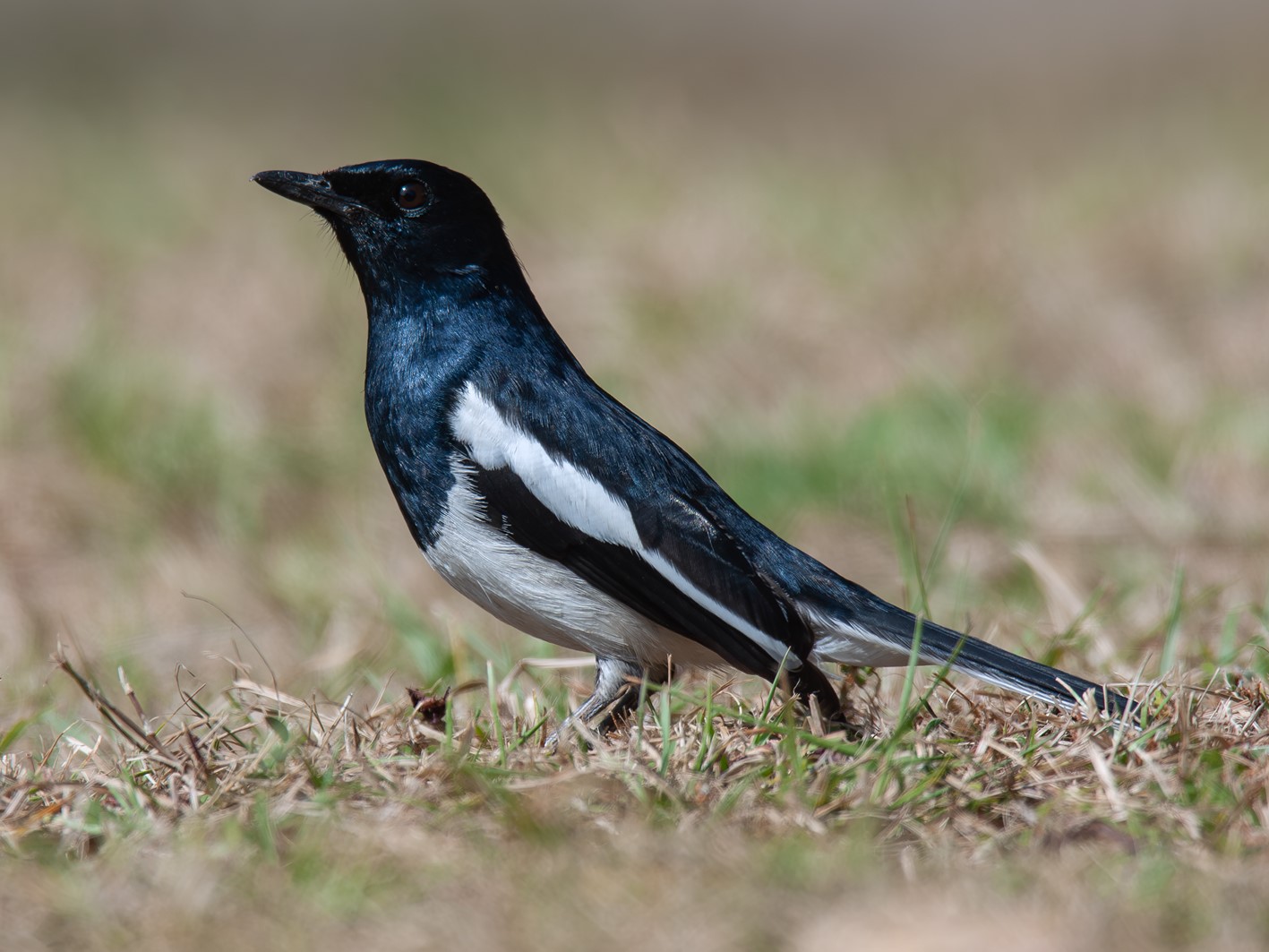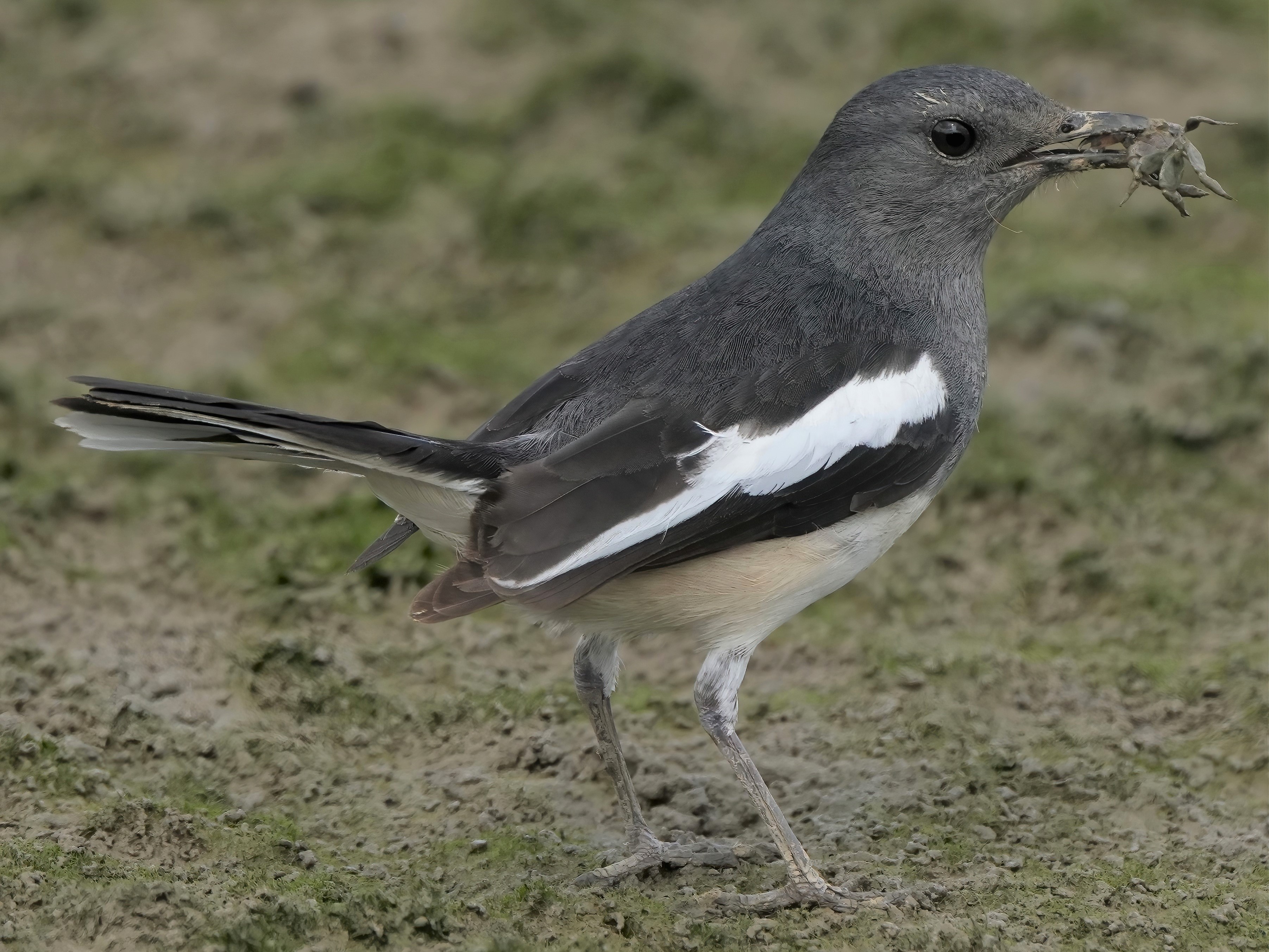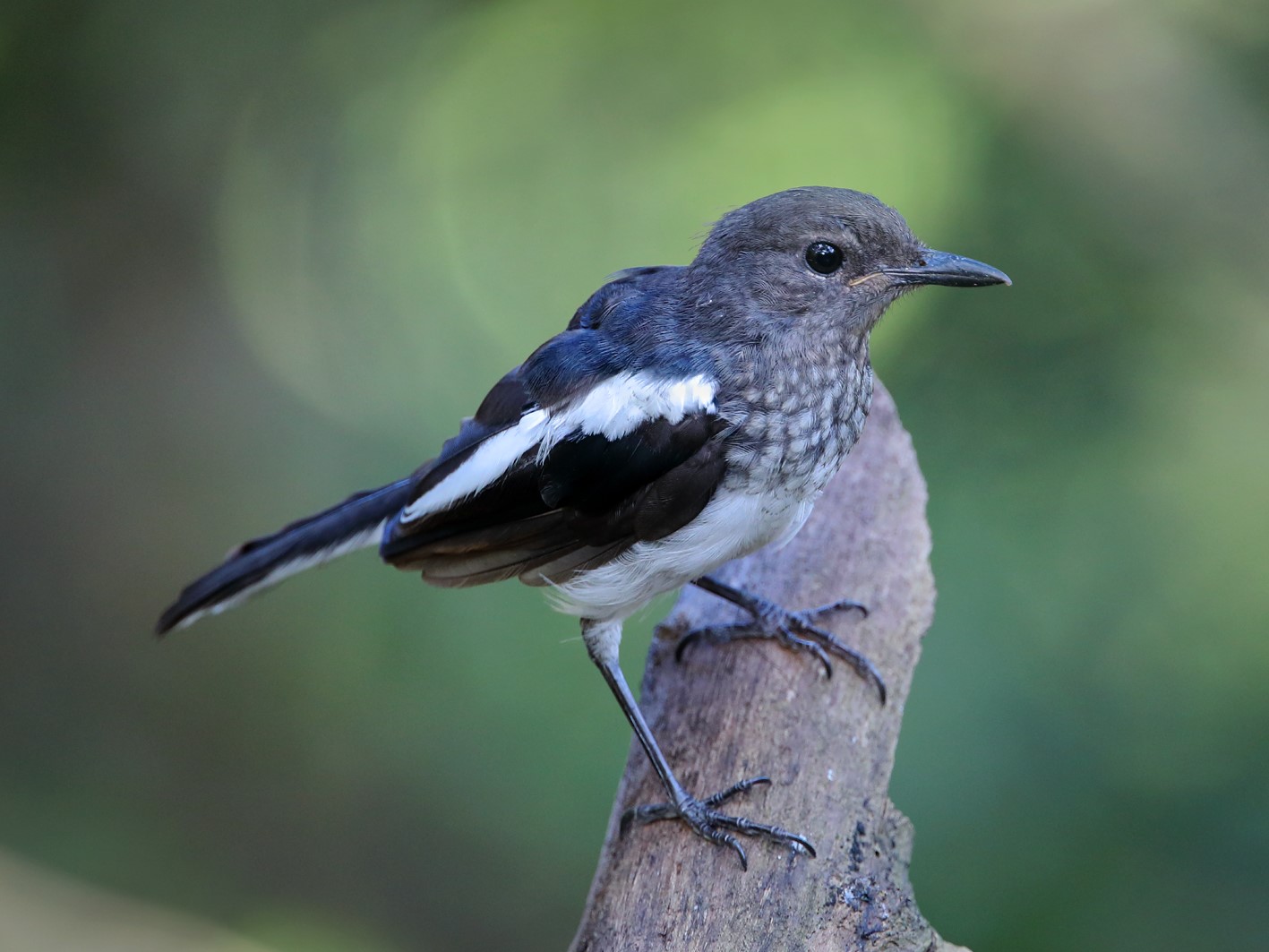Oriental Magpie-Robin Copsychus saularis 鵲鴝
Category I. Abundant, widespread resident over a wide range of habitats.
IDENTIFICATION

Jan. 2008, Michelle and Peter Wong. Adult male.
19–21 cm. The adult male is glossy blue-black above and on breast, with white belly, white bands along wing, white sides of longish graduated black tail; black bill and legs.

Apr. 2023, Paul Leader. Female.
The female is like male but black is replaced with grey, except on wings, and it has buff flanks.

Oct. 2019, Michelle and Peter Wong. Juvenile.
The juvenile is dark brownish-grey above and is mottled dark on the throat and chest.
VOCALISATIONS
A vocal species. The song, which is highly variably among individuals and often contains mimetic elements, is uttered throughout the day, including before dawn when birds may sing in the vicinity of street lights. The pitch is relatively high, though certain elements may reach as low as 2kHz.
Commonly heard calls include ‘swee-woo’, the first element upslurred and higher in pitch than the second, which largely falls in pitch.
Prior to roosting, gives a sharply downslurred ‘syoooo’, sometimes interspersed with a grating ‘chirrr’. The latter is also uttered in alarm, sometimes with a repeated ‘det’ added.
Xeno-canto does not allow free access to recordings that have been uploaded to the site.
DISTRIBUTION & HABITAT PREFERENCE
Oriental Magpie-Robin is a widespread resident that occurs in open country, agricultural areas, villages, parks and gardens in both urban and rural areas generally close to human habitation, a status unchanged since at least the time of Vaughan and Jones (1913). It also occurs in more natural habitat such as woodland edge and mangrove, while it is largely absent from forest, upland area and extensive areas of shrubland.
While it is regular in many localities, large populations are present at Mai Po, Long Valley and villages surrounding the Tai Mo Shan massif (Lam Tsuen and Shek Kong), where peak counts of more than 30 birds are not uncommon. It is also abundant on outlying islands including Lantau, Lamma, Po Toi, Cheung Chau, Tung Lung Chau and the more remote Tung Ping Chau.
Range changes highlighted by the breeding bird survey and winter atlas are somewhat contradictory. The breeding bird surveys of 1993-96 and 2016-19 indicated an increase in the percentage of occupied 1km squares from 45.1% to 49.6%. Conversely, a decrease in the winter atlas surveys of 2001-05 and 2016-19 occurred from 48.7% to 43.2%. However, this is likely to be due to sampling error rather than a genuine distribution change, especially given the overall similarity in figures.
OCCURRENCE
Oriental Magpie-Robin occurs year-round (Figure 1). Most counts concerns singles or a few birds. The highest is 48 individuals at Tai Kong Po, Kam Tin on 22 February 2017, followed by 40 birds at Mai Po on 23 May 2007. Most other high counts (more than 20 birds) are from Mai Po.
BEHAVIOUR, FORAGING & DIET
Strongly territorial, males defend territory in both the breeding and non-breeding season. Feeds largely on ground, hopping about with an upright stance, the tail pumping and the wings partly drooped (Collar et al. 2020). Herklots (1967) stated that food items include small insects, spiders, molluscs, worms and fly maggots, the latter obtained by visiting dung heaps (though there are presumably many fewer of these now). It has also been recorded preying on geckos (at Mai Po on 9 February 2005 and Shek Kong on 8 July 2019).
BREEDING
Oriental Magpie-Robin is highly commensal as it readily breeds in or close to built-up areas, where it utilises nest boxes and other human artefacts for nesting. It also builds in tree trunks, walls or banks, its nests constituting "an untidy cup of leaves, roots, pine needles, feathers and grass" (Herklots 1967). Barretto and Barretto (2020) state that they usually lay five eggs and can be triple-brooded, which was also noted in a nest box at Mount Nicholson in 1984 (Viney 1995). The breeding season extends from February to August, with juveniles generally appearing from April to September, while an exceptionally late juvenile was seen at Ngong Ping on 19 December 2017.
Male Oriental Magpie-Robins are territorial throughout the year, particularly in spring. However, this is largely achieved via vocalisations and it sings readily in all seasons.
RANGE & SYSTEMATICS
Seven subspecies are recognised, but only the nominate race occurs in China. Breeds in Pakistan, India, south and east China (from Shaanxi to Jiangsu, including Hainan), Thailand and Indochina (Collar et al. 2020).
CONSERVATION STATUS
IUCN: Least Concern. Population trend stable.
Barretto, K. and R. Barretto (2020). Bird of the Month. Oriental Magpie Robin Copsychus saularis. Hong Kong Gardening Society Newsletter, September 2020: 5-7.
Carey, G. J., M. L. Chalmers, D. A. Diskin, P. R. Kennerley, P. J. Leader, M. R. Leven, R. W. Lewthwaite, D. S. Melville, M. Turnbull and L. Young (2001). The Avifauna of Hong Kong. Hong Kong Bird Watching Society, Hong Kong.
Collar, N., D. A. Christie, and G. M. Kirwan (2020). Oriental Magpie-Robin (Copsychus saularis), version 1.0. In Birds of the World (J. del Hoyo, A. Elliott, J. Sargatal, D. A. Christie, and E. de Juana, Editors). Cornell Lab of Ornithology, Ithaca, NY, USA. https://doi.org/10.2173/bow.magrob.01
Vaughan, R. E. and K. H. Jones. (1913). The birds of Hong Kong, Macao and the West River or Si Kiang in South-East China, with special reference to their nidification and seasonal movements. Ibis 1913: 17-76, 163-201, 351-384.
Viney, C. (1995). Mount Nicholson – Hong Kong – 1978-1995 – a natural history. Privately published by the author, Hong Kong.

